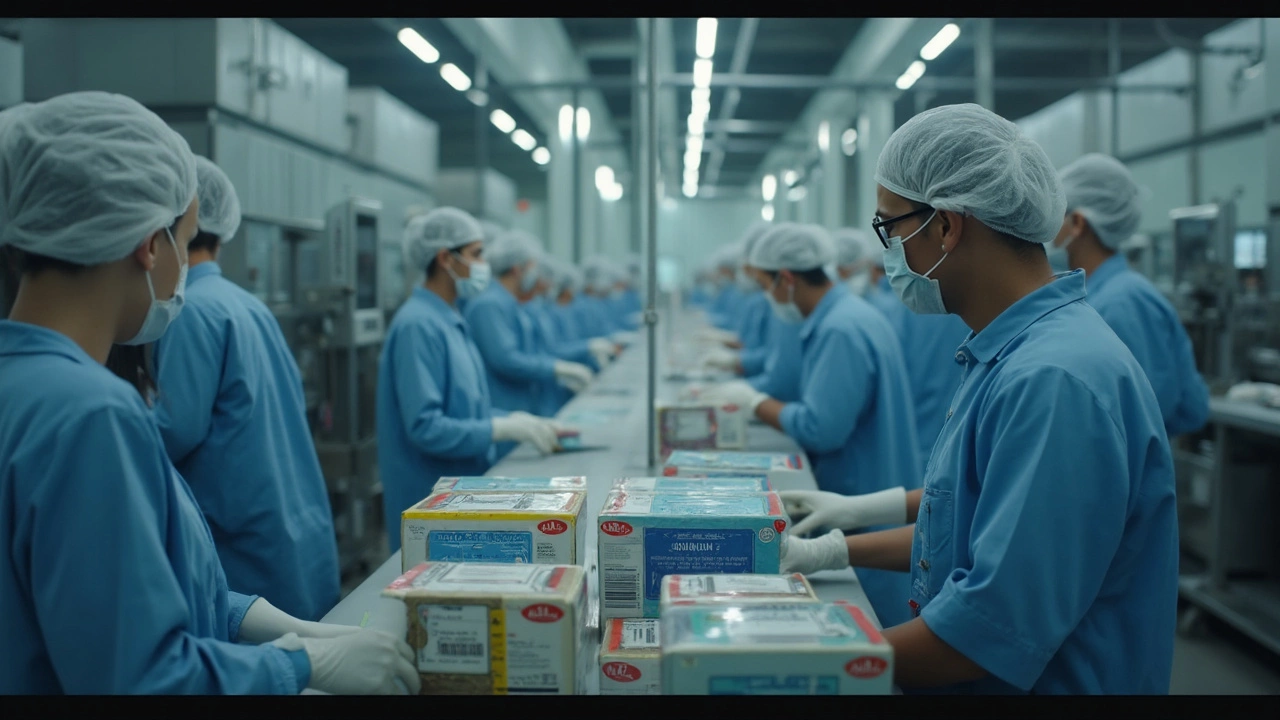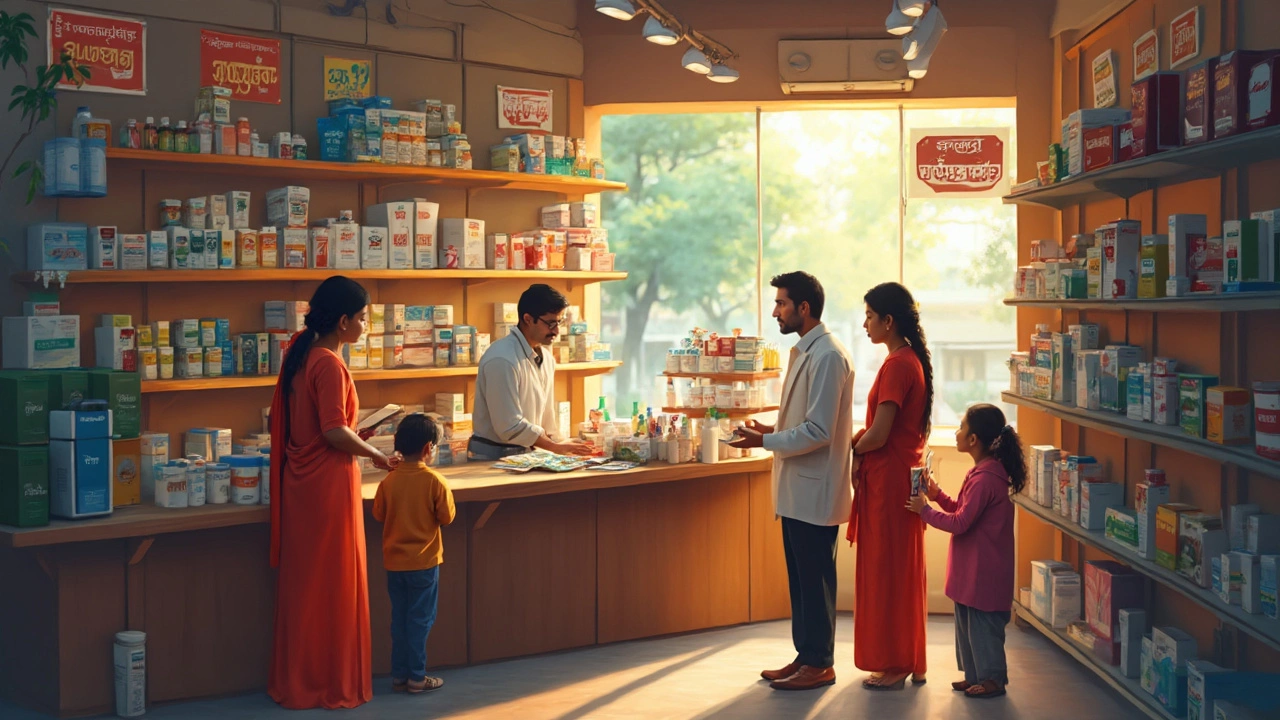The price tag on medicines in India raises eyebrows—sometimes they're 90% cheaper than what you’d pay in the US. It’s not a scam or black magic. This is just how the industry is built here.
Drug manufacturers in India don’t play by the same rules as their Western counterparts. They’re masters at scaling up—think factories that churn out billions of tablets, not just a few batches at a time. When you see low prices on antibiotics or cancer meds, it’s often because these companies have slashed production costs without cutting corners on quality.
But that’s only part of the story. The way the Indian government controls drug prices helps too. Pharma companies can’t just charge whatever they want. There's a cap on what they can ask for essential medicines. That’s why you rarely see the same drug priced wildly differently at two pharmacies in Mumbai.
- How Indian Pharma Manufacturers Keep Prices Low
- The Role of Government Regulations
- Generics vs Brand Names: The Real Price Gap
- What This Means for Buyers and Patients
How Indian Pharma Manufacturers Keep Prices Low
You might wonder how the price of a pack of antibiotics in India can be so low. The answer is all about scale, process, and focus on efficiency. Indian pharma manufacturers are some of the world’s biggest medicine producers, and this size helps them negotiate bulk deals—from raw materials to packaging.
The main driver is the industry’s specialization in generic drugs. Once a patent expires overseas, Indian companies jump in to make their own versions. They don’t spend billions developing new molecules or running massive marketing campaigns. Instead, they figure out how to make existing drugs cheaply and safely.
- Mass production: Factories in cities like Hyderabad and Ahmedabad run pretty much non-stop, turning out millions of pills daily.
- Local sourcing: Ingredients often come from nearby suppliers, cutting transport costs and delays.
- Tech know-how: Indian labs are whizzes at reverse engineering—making a medicine that’s chemically identical to branded versions.
Many top Indian pharma manufacturers—think Sun Pharma, Cipla, Dr. Reddy’s, and Lupin—make both medicines for the local market and export batches to over 200 countries. So, their plants work at a huge scale, pushing per-pill costs way down.
| Factor | Impact on Cost |
|---|---|
| Mass Production | Lowers unit cost significantly |
| Generic Drug Focus | No R&D cost for new drugs |
| Local Supply Chains | Avoids shipping/import expenses |
| Export Volumes | Keeps factories running 24/7 |
Also worth noting: labor costs in India are much lower than in Western countries. Skilled pharmacy graduates are plentiful, and wages are a fraction of what big pharma pays in the West. That helps keep Indian drug prices some of the lowest anywhere.
The Role of Government Regulations
If you’ve ever checked prices for the same medication in India and abroad, the difference is wild. One big reason? The Indian government keeps tight control over medicine prices. It’s not just about setting the rules—it’s about making essential healthcare affordable for all.
Here’s how it works: the National Pharmaceutical Pricing Authority (NPPA) has the job of keeping tabs on prices for hundreds of essential drugs. They update the list every year. As of 2024, more than 350 medicines are on their radar, from simple painkillers to lifesaving cancer meds. These aren’t soft suggestions; if a pharma company tries to charge above the cap, they can get slapped with penalties.
To keep things transparent, anyone can check the maximum retail price (MRP) printed on the packaging. Pharmacies can’t charge you a rupee more. This protects millions from being ripped off, especially if they don’t have insurance. And here’s another thing—local manufacturers don’t have to shell out big bucks in registration or marketing fees like companies do in the US or Europe. Less paperwork and red tape means lower overheads.
Want proof that this really works? Here’s some real data that shows how government oversight affects drug prices:
| Drug Name | India Retail Price (INR) | US Retail Price (INR equiv.) | Price Difference |
|---|---|---|---|
| Atorvastatin (10mg, 30 tablets) | 90 | 2,000 | 95% cheaper |
| Metformin (500mg, 30 tablets) | 40 | 1,100 | 96% cheaper |
| Imatinib (Cancer, 30 tablets) | 3,800 | 90,000 | 96% cheaper |
Big pharma might not always love this system, but for the average person, it’s a lifesaver. Thanks to these regulations, you’ll always find cheap drugs in India compared to most other places, whether you’re at a corner shop in Delhi or ordering online from Bangalore.

Generics vs Brand Names: The Real Price Gap
Here’s where a big chunk of the savings happens in India: cheap drugs India isn’t just marketing—most medicines on sale are generics, not original brands. When you hear "generic drug," think of it as the same recipe for a cake, just made by a different baker. The active ingredient, safety, and effectiveness are the same as the fancy brand everyone knows, but without the high price tag.
Indian drug laws let companies start making generic versions soon after the initial patent expires. Sometimes it’s even faster, thanks to a legal framework that’s pretty business-friendly. Compare that to the US, where brand-name exclusivity lasts years longer—so prices stay high.
It’s not a small side business, either. As of 2023, around 70% of all medicines sold in India were generics. If you walk into a chemist’s shop in Delhi or Chennai, you’re more likely to be offered a generic version than a pricey international brand.
| Drug Name | Brand Price (INR, 2023) | Generic Price (INR, 2023) | Price Difference |
|---|---|---|---|
| Atorvastatin (cholesterol) | 220 | 30 | 86% cheaper |
| Metformin (diabetes) | 54 | 10 | 81% cheaper |
| Azithromycin (antibiotic) | 120 | 35 | 71% cheaper |
This price gap makes treatment more affordable for regular folks. Doctors in India are even encouraged to prescribe generic names, not brands, so patients pay less. You don’t lose out on quality—India’s generics are inspected by international agencies like the US FDA and EMA. In fact, Indian generic drugs fill up medicine cabinets around the world, not just in India.
One quick tip: when picking up medicines at a pharmacy in India, always ask the chemist if there’s a generic substitute. You might save a week’s grocery budget on just one prescription.
What This Means for Buyers and Patients
For shoppers and patients in India, these rock-bottom prices are more than just good news—they can mean the difference between getting needed care and skipping medication. When a month’s supply of a heart medicine costs less than a street snack, sticking to a prescription becomes a whole lot easier.
Let’s get concrete. A 2024 survey across big-city pharmacies found that common antibiotics like amoxicillin cost as little as ₹25 (about $0.30) for a full course, while in the US that same medicine can set you back $10–$20, even with insurance. India’s pricing approach keeps life-saving meds like insulin, anti-TB drugs, and HIV treatments affordable for everyone, not just the wealthy.
| Drug Name | Avg. Price in India (INR) | Avg. Price in US (USD) |
|---|---|---|
| Amoxicillin (10 tabs) | ₹25 | $10 |
| Metformin (30 tabs) | ₹18 | $12 |
| Paracetamol (20 tabs) | ₹13 | $8 |
| Atorvastatin (30 tabs) | ₹73 | $15 |
Here’s what’s cool: India is the world’s biggest supplier of generic medicines, shipping out over 20% of the globe’s generics. If you’re in Africa or Latin America, chances are the pharmacy shelf has Indian-made brands. Many of these are made by top pharma manufacturers, following the same quality controls as in Western countries, but at a fraction of the cost.
Are you travelling to India or have friends coming from there? It’s legal to bring back a small stash of personal-use medicines to most countries—just make sure you bring a doctor’s prescription and check your local import rules to avoid trouble at the airport.
For patients in India, knowing that prices are regulated brings peace of mind. But quality matters too. Look for pharmacies licensed by the government, and ask for a bill—in case of any issues, you want a paper trail. Many urban Indians use online pharmacy apps to compare prices and read reviews, which can be a game changer if you’re watching your health or your wallet.
